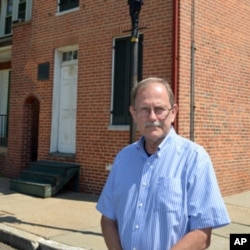Historic homes - where well-known people once lived - attract tourists across America, who seek to connect with the former occupants.
Elvis Presley’s Graceland and George Washington’s Mount Vernon are two of the most popular, but there are also small houses devoted to preserving the memories of the celebrities who once lived there.
Patsy Cline Historic House
Nearly 50 years after her death, Patsy Cline's voice still attracts fans.
Before she became one of America’s best-loved female vocalists, Cline lived in a small, four-room house in Winchester, Virginia, with her mother, brother and sister. She moved there at the age of 16.
Cline's former home is now the Patsy Cline Historic House, which opened to the public this past August.
“When she moved here, she was singing in local talent contests, church functions, anything she could find at that point," says executive director Judy Sue Huyett-Kempf.
Each room in the house contains something that belonged to Cline: a teapot in the dining room; a quilt made by her mother in the bedroom; a pair of red chairs in the kitchen. An end table and lamp in the parlor were once in Cline's Nashville home.
Other furnishings reflect memories Patricia Brannon had of the home. Cline's first cousin, was six years younger than the singer and sometimes gives tours of the house. Brannon visited frequently as a child in the late 1940s.
She is pleased that Winchester is finally honoring her cousin. “They all said that she was born on the wrong side of town. But when they purchased the house and restored it, I think that was one of the best things that happened.”
Cline died in a plane crash at the age of 30 and was buried in Winchester. Her grave has attracted visitors for years. But Huyett-Kempf, who was behind the fundraising efforts to establish a Patsy Cline Museum in Winchester, says fans have been waiting for this recognition.
They purchased the house about five years ago, but continued to look for a site for a museum. "Then it dawned on us," she says. "This is the Patsy history. This is it, where she walked, where she ate, where she slept."
Because the house is so small, only 20 visitors can tour at a time. In the first five days, Huyett-Kempf says, they had more than 600 people.
Birthplace of baseball legend
Babe Ruth was born in a working class neighborhood in Baltimore, Maryland, on February 6, 1895.
He's idolized as one of the best baseball players ever and the first sports superstar, according to Mike Gibbons, executive director of the Babe Ruth Birthplace and Museum.
“He is the first guy who ever had a sports agent. He is the first guy who was used to promote retail goods.”
Ruth’s birthplace, which was scheduled to be demolished in the 1960s, was rescued and restored by Baltimore residents and has been open to the public for almost 40 years.
“With this house, we give them plenty of opportunities to touch where Babe Ruth walked around," Gibbons says, "He did not live here, but this was his grandparents’ house, so he was in and out of this house for the first seven years of his life.”
The bedroom where Ruth was born and the front parlor have been furnished as they were when his grandparents lived here.
And because the city saved three adjoining houses as well, there's room for artifacts tracing Ruth’s life, from his first mitt, used in childhood baseball games, to his early career in Baltimore, and beyond to celebrity.
Edgar Allan Poe's home endangered
The oldest house in Baltimore is a narrow, two-story, brick building surrounded by low-income housing. Back in the early 1830s, it was home to Edgar Allan Poe, one of America’s most famous writers.
Poe is mostly known for his scary stories and poems.
“He was around 25 years old at the time he lived here," says Jeff Jerome, curator of the Edgar Allan Poe House. "He shared this small house with his two cousins, Henry and Virginia, his aunt Maria Clemm and his grandmother.”
Poe’s attic bedroom is furnished as historians believe it was when the writer lived there. “He probably had a bed, very similar to the one that we have. He had a chair, a washstand, and maybe a small table.”
More objects are on display in other rooms. A telescope and china from his boyhood home in Richmond and, in the front parlor, a chair that belonged to the writer. There isn’t room for much else.
But, as Jerome points out, that hasn’t stopped people from travelling great distances to visit the house.
“We had a young lady, 16 years old, that came here from China with her father and she said she was a poet," Jerome recalls. "Her father said, ‘We came to America to visit Poe’s grave and his house.’”
According to Jerome, the visitors had no interest in travelling 30 minutes south to visit Washington, D.C. Their sole reason for coming to the U.S. was to pay homage to Poe.
The curator says he hears that lot from people who tour the house. But next summer if they come, they may find the door locked.
“The city of Baltimore cut funding to the Poe house. We are now surviving off of funds that I have raised through the Poe Birthday celebration and Halloween at the Poe House," Jerome says.
The budget year ends in June 2012. Jerome hopes someone will step forward before the money runs out, so that the house can be kept open to the public.









